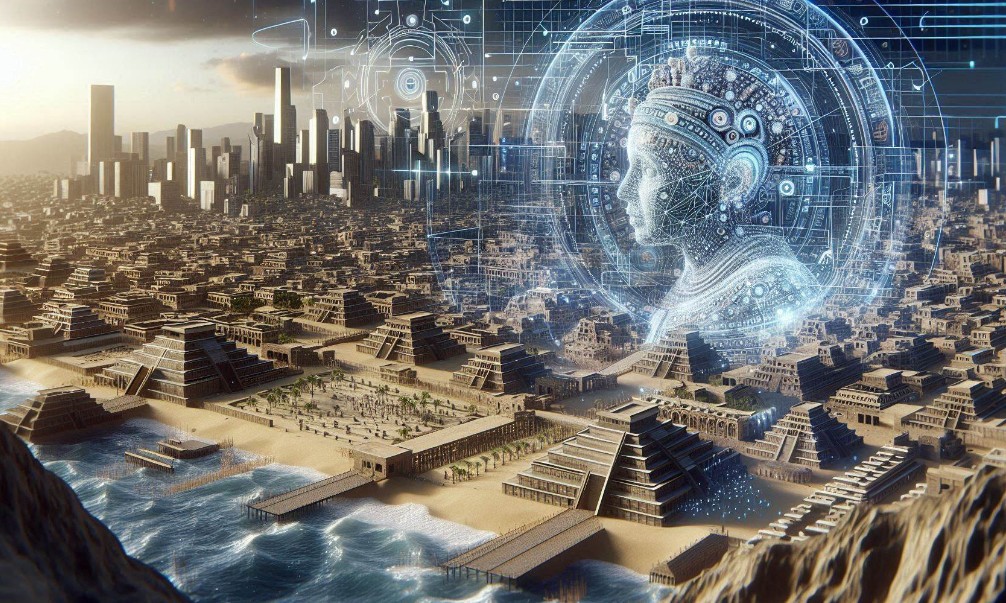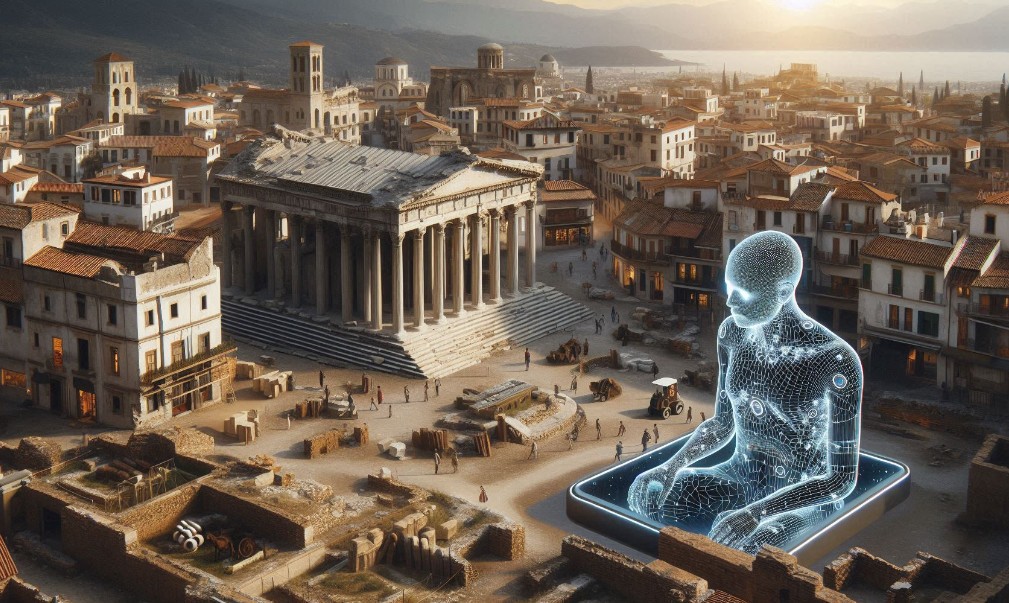In recent years, there has been a significant advancement in the field of Artificial Intelligence (AI) and Augmented Reality (AR). These technologies have become increasingly popular and have the potential to enhance virtual experiences in various fields such as gaming, education, healthcare, and...
Artificial intelligence aids archaeologists in the reconstruction of ancient urban landscapes

Artificial intelligence (AI) is ushering in a new era for archaeology, offering unprecedented tools and methodologies to unearth and reconstruct the mysteries of ancient cities. Through advanced algorithms and machine learning models, AI is enabling archaeologists to piece together fragmented remains, faded inscriptions, and scattered artifacts with remarkable accuracy.
Using computer vision techniques, AI can analyze aerial and satellite imagery to identify subtle features beneath the earth's surface that might indicate the layout of ancient urban centers. This capability allows researchers to map out the spatial organization of cities long lost to time, providing insights into their infrastructure, residential areas, and public spaces.
Machine learning algorithms are also pivotal in deciphering ancient texts and languages engraved on archaeological artifacts. By training on vast datasets of linguistic patterns and historical contexts, AI can assist in translating and interpreting ancient scripts, shedding light on cultural practices, governance structures, and societal norms of these bygone civilizations.
Moreover, AI-powered simulation models enable archaeologists to digitally reconstruct ancient cities in 3D, offering immersive experiences that transport researchers and the public alike back in time. These virtual reconstructions not only visualize the architectural splendor of ancient urban landscapes but also provide invaluable insights into urban planning, construction techniques, and daily life.
Enhancing Archaeological Insights
Artificial intelligence (AI) is revolutionizing the field of archaeology by providing powerful tools to analyze and interpret ancient artifacts and sites. Here are some key ways AI enhances archaeological insights:
- Automated Analysis: AI algorithms can process large volumes of archaeological data quickly, identifying patterns and anomalies that might be missed by human researchers.
- Site Reconstruction: Using machine learning and computer vision, AI can reconstruct ancient cities and structures from fragmented remains, offering new perspectives on their layout and function.
- Artifact Classification: AI models can classify and categorize artifacts based on shape, material, and cultural context, aiding in dating and understanding their significance.
- Language Deciphering: Natural language processing algorithms help decipher ancient scripts and inscriptions, unlocking historical texts and records.
- Predictive Modeling: By analyzing historical data, AI can predict archaeological sites' locations, guiding fieldwork and excavation efforts more effectively.
These AI-driven insights not only accelerate research processes but also contribute to a deeper understanding of ancient civilizations, their technologies, and social structures.
Utilizing AI to Reconstruct Ancient Urban Landscapes
Artificial intelligence (AI) has revolutionized the field of archaeology by offering powerful tools to reconstruct and visualize ancient urban environments. By leveraging advanced algorithms and machine learning models, AI can analyze fragmented historical data and interpret archaeological findings in unprecedented ways.
The Role of AI in Data Analysis
One of the primary applications of AI in reconstructing ancient urban landscapes is its ability to process vast amounts of archaeological data swiftly and accurately. AI algorithms can sift through excavation reports, historical texts, geographical surveys, and even satellite imagery to identify patterns and reconstruct the layout of ancient cities.
Enhancing Accuracy and Visualization
AI-driven reconstruction techniques enhance the accuracy of recreating ancient urban landscapes. By integrating 3D modeling with AI algorithms, archaeologists can visualize how cities might have looked in different historical periods, considering factors like architecture, infrastructure, and social organization.
Moreover, AI enables the integration of diverse datasets, including cultural artifacts, architectural remnants, and historical records, to create comprehensive digital models of ancient urban environments. This interdisciplinary approach not only aids in historical research but also fosters public engagement and educational outreach.
Revolutionizing Data Analysis
Artificial intelligence (AI) is transforming the field of archaeology by revolutionizing data analysis methodologies. This technological advancement enables archaeologists to process vast amounts of data with unprecedented speed and accuracy, facilitating the reconstruction of ancient cities and civilizations.
Enhanced Data Processing
AI algorithms excel at analyzing diverse datasets, including satellite imagery, LiDAR scans, historical documents, and archaeological findings. By swiftly identifying patterns and correlations across these sources, AI significantly accelerates the data processing phase.
Predictive Modeling and Reconstruction
Using AI-powered predictive modeling, archaeologists can simulate how ancient cities might have looked based on fragmented remains and historical records. Machine learning algorithms can reconstruct 3D models from scattered ruins and artifacts, offering insights into urban planning, architecture, and societal structures of bygone eras.
Through AI, archaeologists are not only uncovering hidden histories but also preserving cultural heritage for future generations.

How AI Algorithms Interpret Historical Site Data
Artificial intelligence plays a crucial role in the interpretation of data gathered from historical sites, enabling archaeologists to uncover and reconstruct ancient cities with unprecedented accuracy and detail.
Data Processing and Pattern Recognition
AI algorithms excel in processing vast amounts of archaeological data, including aerial scans, ground-penetrating radar images, and historical texts. By applying machine learning techniques, these algorithms can identify patterns and anomalies that human researchers might overlook.
3D Reconstruction and Visualization
One of the significant contributions of AI in archaeology is its ability to reconstruct ancient cities in 3D based on fragmented remains and historical records. By integrating data points from various sources, AI algorithms generate detailed models that archaeologists can explore virtually.
| Technique | Description |
|---|---|
| LiDAR Mapping | Uses laser light to create detailed maps of terrain and vegetation, revealing hidden archaeological features. |
| Neural Networks | Trainable algorithms that recognize and classify patterns in ancient artifacts and historical documents. |
| GIS Integration | Geographic Information Systems combine spatial data to analyze ancient landscapes and settlement patterns. |
This HTML snippet creates a structured section discussing how AI algorithms interpret historical site data, highlighting their roles in data processing, pattern recognition, 3D reconstruction, and visualization in archaeology.
Preserving Cultural Heritage
Preserving cultural heritage is paramount in safeguarding our history and identity. Through the integration of artificial intelligence, archaeologists are revolutionizing the way ancient cities and artifacts are reconstructed and preserved.
AI algorithms analyze vast datasets of archaeological findings, meticulously piecing together fragmented remains to recreate detailed 3D models of ancient cities. These models provide invaluable insights into urban planning, daily life, and cultural practices of civilizations long past.
Furthermore, AI enhances preservation efforts by predicting environmental degradation risks and recommending conservation strategies. By digitally preserving these treasures, AI ensures that future generations can learn from and appreciate our rich cultural heritage.
With AI's assistance, archaeologists can delve deeper into the past, uncovering hidden narratives and preserving the legacy of our ancestors for generations to come.



